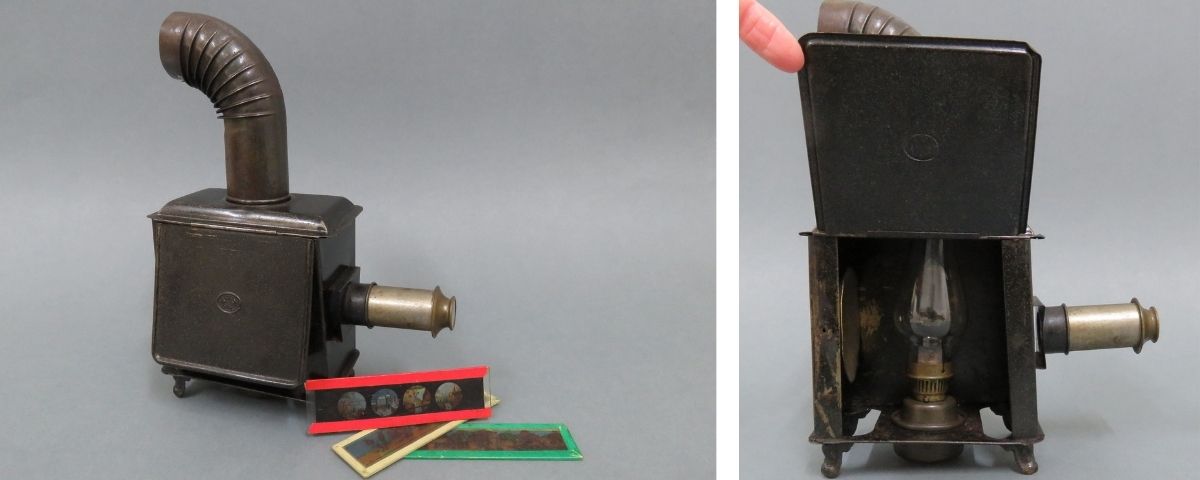Georgia Kerby, Exhibitions Curator
Toys designed for children commonly mimic aspects of adult life in cartoon or miniature form. This is part of what makes them so much fun, acting the adult but without all the responsibility! One of the most interesting toys in Whangarei Museum’s collections is a toy magic lantern and a collection of colourful glass slides. With the Museum’s imminent ‘Magica Lanterna’ exhibition on the near horizon, the staff have been delving into the history of this magical art form.
In a nutshell, magic lanterns, or stereopticons, were the earliest image projectors. They were invented in the 1660s originally using a candle and glass lenses to project and magnify a semi-transparent image hand drawn on a piece of glass. With the rise of mechanical tools and a fashion for self-improving entertainment in Victorian-era England, magic lantern shows became immensely popular. Adopted by every society, business, academia and entertainers a large magic lantern industry boomed around the globe. Shows created by projecting series of slides with lanterns were put on for education, entertainment and advertising purposes.

In the last few decades of the 1800s, magic lanterns found their way into the home. Smaller, more lightweight and cheaply made lanterns were produced for the domestic market. Two types were specifically advertised; the first as a parlour lantern for operation by parents. The second was a more basic version supposedly safer for the eldest child to operate, although it still required management of a kerosene lamp (also known as petroleum paraffin oil). The second style can be seen in our new exhibition from the 13th November.
Our toy lantern was donated by M. Dawson in the 1960s and is a prime example of a turn of the century German toy lantern, likely dating between1900 and1925. It is small and would have been relatively cheap compared to large lanterns designed for lectures and public entertainment. Its lightweight body and tall arched chimney are made from blued sheet tin. The bodies of magic lanterns were normally made from sheet iron, steel or tin, lacquered for a ‘blued’ finish or painted black.
A hinged flap on one side opens up to reveal a small kerosene lamp with glass chimney which could be handled by children. A concave brass disk is mounted behind the lamp to reflect as much light as possible through the slide in front. Most toy lanterns were sold as sets with a series of glass slides, a theatrical script, faux posters and tickets for your audience all kept in a wooden or metal box.
Our set was donated with a series of 23 rectangular glass slides, each bound with red, green and white gummed tape. Many brightly coloured slides misidentified as hand painted, following the earlier method of slide production. Instead, the tiny scenes are the result of chromolithography used in the decalomania method, originating in decorative ceramics. Simply called ‘decals’, these slides were mass produced by transferring a printed image in multiple colours (chromes) onto a prepared glass slides. The backgrounds of some of these slides have been painted in black to highlight each scene. Others were designed to be continuously pushed through the magic lantern for an ever-changing scene. Aimed at children, the images in this collection range from comedic sketches such as a maid eavesdropping to views of exotic places.
Most toy lanterns were made in Germany and Ernst Plank was a big contributor and at its peak was a top magic lantern producer worldwide. Their logo, a small winged wheel with the letters “EP”, is stamped on the door of our magic lantern. Starting in 1866, Ernst Plank specialised in tin toys such as trains and lanterns. In 1902 they also sold camera obscuras and ‘Kinematographs’ which were built like a magic lantern but had handles to wind reels of early celluloid film behind the lens. In the most interesting period of cinema entertainment, magic lanterns like this Ernst Plank toy operated alongside new film projectors until the talking movies of the late 1920s superseded their novelty. While seen then as a modest relic of a past global phenomenon, little magic lanterns like these now have a charming ‘magic’ magnified by their survival over yet another century.
This toy magic lantern and some of its slides will be featured in the new exhibition “Magica Lanterna” which opens 13th November, and is included in Kiwi North admission.